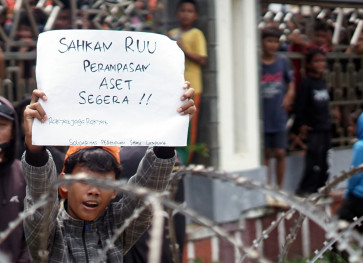Popular Reads
Top Results
Can't find what you're looking for?
View all search resultsPopular Reads
Top Results
Can't find what you're looking for?
View all search resultsMDG Summit: Achievements and future challenges
The Millennium Development Goal (MDG) Summit was held in New York from Monday until Wednesday
Change text size
Gift Premium Articles
to Anyone
The Millennium Development Goal (MDG) Summit was held in New York from Monday until Wednesday.
The summit is considered a crucial event, since the aim of the MDGs is to halve the number of poor people and to achieve certain targets in the areas of health, gender equality, education, infrastructure and the environment by 2015.
The world has prospered over the last two decades and consequently the progress of the MDGs had been mostly on track. Prosperity stagnated and progressively declined when a combination of world crises (the food, fuel and financial crises) occurred in 2008.
According to the World Bank report “Unfinished business: Mobilizing new efforts to achieve the 2015 Millennium Development Goals”, the global poverty figure had fallen more than 50 percent during the period between 1981 (52 percent of people living in extreme poverty) and 2005 (25 percent).
However, the global crisis in 2008 and 2009 reversed the positive progress, and even contributed to send an additional 70 million in the world into extreme poverty and hunger and make another 34 million people unemployed.
Middle-Income Countries (MICs) and most countries in East Asia Pacific and Latin America are among the developing countries enjoying the sharp decline in poverty levels and are on track to achieve the other MDGs. Resource attractiveness including resource endowments, prudent macroeconomic and business climate policies, and market openness and size are among the factors contributing to the countries’ high growth.
Despite this progress, MICs are still home to a majority of the world’s poor and continue to face major challenges in achieving the other human development goals such as in education and health.
The Sub-Saharan Africa (SSA) region is still facing huge difficulties in achieving the MDGs. Internal conflict, fragile states and security issues, the lack of infrastructure and energy, less access to markets and less effort in human capital are among the main factors hindering its achievement of the MDGs.
The SSA region requires more assistance from multilateral institutions and donor countries, compared to countries in other regions, in addressing the region’s development agenda.
Additional financing (in loans and grants) from multilateral agencies and donor countries is one of the main factors to accelerating the achievement of the MDGs. Additional financing will bring more programs for eradicating poverty and increasing human development, and is relevant especially for countries facing financial shortages in addressing their development agenda. Therefore, the global crises should not be the reason for developed countries to reduce their commitment in the MDGs field.
Indonesia is moving positively toward their MDGs for 2015. However, the target will be difficult to attain unless Indonesia accelerates efforts to fight the hunger represented by children under five and reduce the maternal mortality rate. The efforts should not only focus on providing better health services and nutrition, but also cover a broad spectrum including infrastructure, socioeconomics, agriculture and education levels.
Extra efforts should be taken too in overcoming the poverty level. Even though Indonesia is expected to achieve its MDG target of halving the number of poor people before 2015, the criteria is considered too low based on the purchasing power parity (PPP) indicator. When using the national poverty line, the proportion of people living below the line stood at 15.1 percent, or approximately 27 million people (MDGs Indonesia, 2007). To reduce the figure to half, or 7.6 percent, or even lower in 2015, public and private sectors should work together to boost economic growth to at least 7 percent.
The high positive growth will create a virtuous circle of increasing investment and production, providing more jobs, escalating incomes, enlarging consumption and consequently leading to higher growth.
Contribution from the private sector is very much required, especially in small and medium enterprises (SMEs), since around 80 percent of investment comes from this sector.
It is clear that the global economic recovery is the critical factor in achieving the MDGs. Some countries, especially MICs, have shown positive growth. Yet, the recovery is considered temporary, and there are uneven results among countries. Most countries are currently still facing negative growth with huge budget deficits, and consequent increases in the countries’ debt ratio. The latter actually decreases the countries’ capability in achieving the MDGs.
High, balanced and sustainable growth among countries, as declared by the G20 Summit in Toronto last June, should become the main principle when each country’s authority determines its fiscal and monetary policies. Sustainable growth requires discipline in revenue, by maximizing tax revenue while promoting a good business transaction climate, and on the expenditure side, through cutting unnecessary subsidies borne by the government while investing in long-term benefit programs.
This approach will result in additional fiscal space, lower the country’s debt ratio and prevent future crises. The fiscal space can be optimized through investing in infrastructure and human development.
While balancing growth will create multi-polar growth in many countries, reducing dependency on certain traditional developed countries’ markets.
Indonesia, as the third-highest growth country in the G20, can easily achieve its MDGs goal. And the MDG indicators can be even be stringent for a better quality of life for the people, if Indonesia can maintain high and sustainable growth. The challenge is how all stakeholders, public and private sectors can maximize their role and synergize through concerted action, based on each party’s expertise, to bring benefits to the country and its people.
The writer is the alternate executive director of the World Bank for the Southeast Asia Group.










